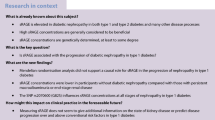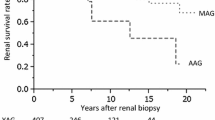Abstract
We report a case of smoking-related idiopathic nodular glomerulosclerosis (ING) with overexpression of glomerular advanced glycation end products (AGEs) and their receptor (RAGE). A 59-year-old Japanese man with nephrotic syndrome, who had a smoking history of one pack of cigarettes per day for approximately 40 years, presented with a 3-year history of urinalysis abnormalities without clinical evidence of diabetic mellitus. The patient’s leg edema progressively worsened over the previous 2 years, and he was admitted to our hospital. Renal biopsy showed mesangial expansion with diabetic Kimmelstiel–Wilson-like nodular lesions, glomerular basement thickening, and arteriosclerosis. No electron-dense deposits, fibrils, or microtubule deposits were seen in the glomeruli on electron microscopy. Skin AGE level measured using AGE reader was higher in this case than the average level in age-matched Caucasians. In addition, immunohistochemical analysis revealed that N-carboxymethyl lysine, one of the major AGEs, and RAGE were overexpressed and podocin expression was decreased in the peripheral area of the glomerular nodular lesions. These observations suggest that AGEs–RAGE system may be activated in smoking-related ING, possibly leading to the progression of renal dysfunction.





Similar content being viewed by others
References
Markowitz GS, Lin J, Valeri AM, Avila C, Nasr SH, D’Agati VD. Idiopathic nodular glomerulosclerosis is a distinct clinicopathologic entity linked to hypertension and smoking. Hum Pathol. 2002;33(8):826–35.
Stinghen AE, Massy ZA, Vlassara H, Striker GE, Boullier A. Uremic toxicity of advanced glycation end products in CKD. J Am Soc Nephrol. 2016;27(2):354–70. https://doi.org/10.1681/ASN.2014101047.
Mao Y, Ootaka T, Saito T, Sato H, Sato T, Ito S. The involvement of advanced glycation endproducts (AGEs) in renal injury of diabetic glomerulosclerosis: association with phenotypic change in renal cells and infiltration of immune cells. Clin Exp Nephrol. 2003;7(3):201–09. https://doi.org/10.1007/s10157-003-0245-z.
Fukami K, Taguchi K, Yamagishi S, Okuda S. Receptor for advanced glycation endproducts and progressive kidney disease. Curr Opin Nephrol Hypertens. 2015;24(1):54–60. https://doi.org/10.1097/MNH.0000000000000091.
Rhee H, Song SH, Kwak IS, Kim IY, Seong EY, Lee DW, et al. An explorative analysis of secretory receptor for advanced glycation endproducts in primary focal segmental glomerulosclerosis. Clin Exp Nephrol. 2012;16(4):589–95. https://doi.org/10.1007/s10157-012-0599-1.
Tomino Y, Hagiwara S, Gohda T. AGE-RAGE interaction and oxidative stress in obesity-related renal dysfunction. Kidney Int. 2011;80(2):133–5. https://doi.org/10.1038/ki.2011.86.
Park EY, Kim BH, Lee EJ, Chang E, Kim DW, Choi SY, et al. Targeting of receptor for advanced glycation end products suppresses cyst growth in polycystic kidney disease. J Biol Chem. 2014;289(13):9254–62. https://doi.org/10.1074/jbc.M113.514166.
Cerami C, Founds H, Nicholl I, Mitsuhashi T, Giordano D, Vanpatten S, et al. Tobacco smoke is a source of toxic reactive glycation products. Proc Natl Acad Sci USA. 1997;94(25):13915–20.
Biswas SK, Mudi SR, Mollah FH, Bierhaus A, Arslan MI. Serum soluble receptor for advanced glycation end products (sRAGE) is independently associated with cigarette smoking in non-diabetic healthy subjects. Diab Vasc Dis Res. 2013;10(4):380–2. https://doi.org/10.1177/1479164113479618.
Prasad K, Dhar I, Caspar-Bell G. Role of advanced glycation end products and its receptors in the pathogenesis of cigarette smoke-induced cardiovascular disease. Int J Angiol. 2015;24(2):75–80. https://doi.org/10.1055/s-0034-1396413.
Vestbo J, Hurd SS, Agustí AG, Jones PW, Vogelmeier C, Anzueto A, et al. Global strategy for the diagnosis, management, and prevention of chronic obstructive pulmonary disease: GOLD executive summary. Am J Respir Crit Care Med. 2013;187(4):347–65. https://doi.org/10.1164/rccm.201204-0596PP.
Koetsier M, Lutgers HL, de Jonge C, Links TP, Smit AJ, Graaff R. Reference values of skin autofluorescence. Diabetes Technol Ther. 2010;12(5):399–403. https://doi.org/10.1089/dia.2009.0113.
Nomoto K, Yagi M, Arita S, Ogura M, Yonei Y. Skin accumulation of advanced glycation end products and lifestyle behaviors in Japanese. Anti Aging Med. 2012;9(6):165–73.
D’Agati VD, Chagnac A, de Vries AP, Levi M, Porrini E, Herman-Edelstein M, et al. Obesity-related glomerulopathy: clinical and pathologic characteristics and pathogenesis. Nat Rev Nephrol. 2016;12(8):453–71. https://doi.org/10.1038/nrneph.2016.75.
Jaimes EA, Tian RX, Joshi MS, Raij L. Nicotine augments glomerular injury in a rat model of acute nephritis. Am J Nephrol. 2009;29(4):319 – 26. https://doi.org/10.1159/000163593.
Salvatore SP, Troxell ML, Hecox D, Sperling KR, Seshan SV. Smoking-related glomerulopathy: expanding the morphologic spectrum. Am J Nephrol. 2015;41(1):66–72. https://doi.org/10.1159/000371727.
Wu L, Ma L, Nicholson LF, Black PN. Advanced glycation end products and its receptor (RAGE) are increased in patients with COPD. Respir Med. 2011;105(3):329–36. https://doi.org/10.1016/j.rmed.2010.11.001.
Durvasula RV, Petermann AT, Hiromura K, Blonski M, Pippin J, Mundel P, et al. Activation of a local tissue angiotensin system in podocytes by mechanical strain. Kidney Int. 2004;65(1):30–9. https://doi.org/10.1111/j.1523-1755.2004.00362.x.
Fukami K, Yamagishi S, Kaifu K, Matsui T, Kaida Y, Ueda S, et al. Telmisartan inhibits AGE-induced podocyte damage and detachment. Microvasc Res. 2013;88:79–83. https://doi.org/10.1016/j.mvr.2013.04.006.
Soulis T, Thallas V, Youssef S, Gilbert RE, McWilliams BG, Murray-McIntosh RP, et al. Advanced glycation end products and their receptors co-localise in rat organs susceptible to diabetic microvascular injury. Diabetologia. 1997;40(6):619–28. https://doi.org/10.1007/s001250050725.
Acknowledgements
The authors would like to thank the members of the Kyusyu Okinawa Kidney Biopsy forum for their useful discussion. The authors also would like to thank Enago (http://www.enago.jp) for English language review.
Author information
Authors and Affiliations
Corresponding author
Ethics declarations
Informed consent
Informed consent was obtained from the patient in this study.
Conflict of interest
The authors declare that no conflict of interest exists.
About this article
Cite this article
Nakamura, N., Taguchi, K., Miyazono, Y. et al. AGEs–RAGE overexpression in a patient with smoking-related idiopathic nodular glomerulosclerosis. CEN Case Rep 7, 48–54 (2018). https://doi.org/10.1007/s13730-017-0290-1
Received:
Accepted:
Published:
Issue Date:
DOI: https://doi.org/10.1007/s13730-017-0290-1




